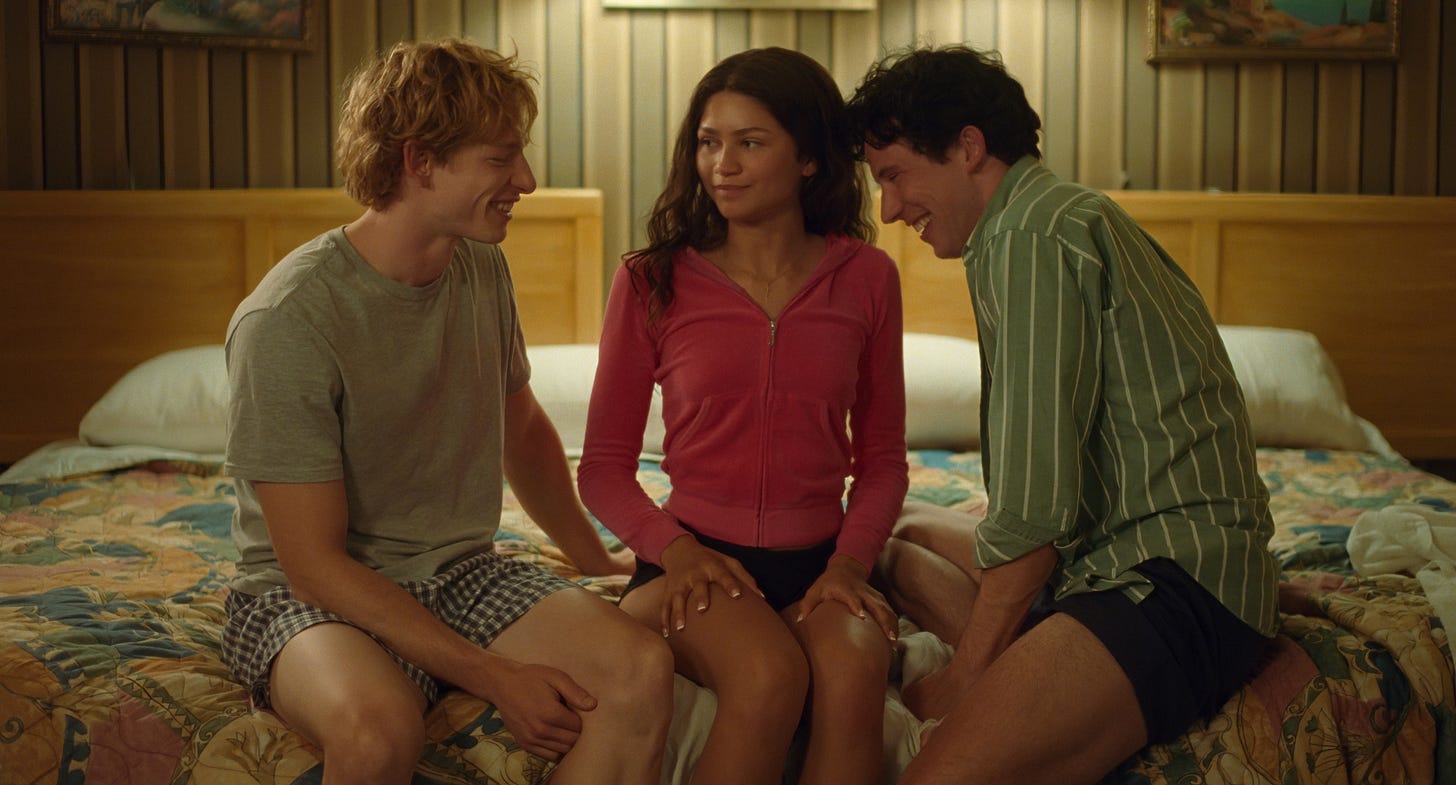Challengers
A love triangle that doubles as an exploration of intimacy and competition
Challengers braids competition, intimacy, and the need to win into an aggressive love triangle. The story, written by Justin Kuritzkes, is a natural fit for director Luca Guadagnino’s maximalist sensibilities, which he indulges through showy camerawork and a pounding score by Trent Reznor and Atticus Ross. Script, cinematography, and score all compete with each other to be the showiest element of the story, each taking over the spotlight from the others in turn: sharp dialogue suddenly replaced by pulsing synths, then traded in for the snap of a camera flourish. Rather than drowning each other out, these three elements serve to propel the story like doubles partners trading volleys.
Tashi (Zendaya) is tennis royalty, a former champion who was forced to turn to coaching after a debilitating knee injury. She’s also one half of a tennis power couple with her husband, Art (Mike Faist), who is struggling to overcome nerves in time to compete in the US Open after his own sports injury. To help him regain his equilibrium, Tashi enters Art into a challenger-level match, where he must face off against Pat (Josh O’Connor), his former best friend and Tashi’s ex-boyfriend. The resulting match reignites passions dating back to Art, Pat, and Tashi’s college days, threatening to push each of the trio to the breaking point.
Challengers bounces between the perspectives of its leads in an attempt to balance the three-way tug of its love triangle. The film grounds itself in its characters’ shared history, with a significant amount of time spent deepening its foundational stakes in flashback. (It’s a testament to the film’s casting and makeup departments that Faist and O’Connor can both pass for eighteen-year-olds and early thirtysomethings in the same film; Zendaya’s character is a touch less believable as her older self, though she makes up for the lack of gravity in part through icy aloofness.) With every turn of the plot, the movie reveals an additional layer of desires and betrayals until the story starts to edge into melodrama.
For a movie billed as a sexy adult drama, and for all the flourishes with the camera, Guadagnino’s direction is remarkably coy about the physical contact between the movie’s characters, electing to fade to black whenever the off-court action begins to get heavy. Challengers isn’t really a movie about sex anyway, although sexual desire certainly plays a role in the drama. It’s more about intimacy and the ways that a person can sometimes be understood better by an opponent than by a lover. Tashi compares her tennis matches to relationships. She claims she understands her opponents better than anyone when she’s facing them on the court, and she attacks with a single-minded ferocity: if I know you, then I know how to beat you.
Off-court, Tashi is unable to stop competing; she says that all she knows is how to hit a ball with a racquet, even after her own sporting career is over. Whenever she fights, whether it’s with Art or with Pat, the camera whips back and forth, mimicking tennis volleys as they trade shots. In two separate fights, the sparring turns into talk about tennis, and each time her interlocutor is surprised to find that Tashi’s really been thinking about the sport all along.
Zendaya’s performance as the younger version of herself is an open book, full of the promise of her potential; her older self is harder to read, even as the script presents Challengers as her story. The single-mindedness of her character is so straightforward as to be almost disappointing. She’s focused so deeply on winning that her encounters with both Art and Pat read almost as dalliances, even after she and Art have been married for years. Her character’s choices all make sense on paper, but the film doesn’t quite manage to give her decisions the weight they deserve, given the stakes. Combined with the slight lack of chemistry between Zendaya and O’Connor, this causes Tashi and Pat’s corner of the triangle to wobble.
By contrast, Art and Pat share an easy intimacy fueled by the chemistry between Faist and O’Connor, especially in flashback sequences. They’re inseparable, and when Tashi meets them for the first time she claims she can’t just pick one of the two or else she’d be a “home-wrecker.” Pat and Art laugh her off, but up until this point, the two have moved together as a single unit. As they sit down at a cafeteria table in one scene, Pat uses his foot to hook the bottom rung of a stool to pull Art’s chair closer to his own before Art is fully seated. It’s a swift gesture, almost thoughtless, but Guadagnino dedicates an entire insert shot to the motion of the foot moving the chair, underlining the fact that these two boys know and understand each other. They are more comfortable around each other than with anyone else in the world.
That intimacy is ruptured—and clarified—by their competition with each other over Tashi. Challengers is at its best whenever two characters are sparring, sizing each other up, engaging each other in play. “Tennis is a relationship,” says Tashi, the kind that requires both sides to throw themselves body and soul into competition. If you’re playing the game right, it can only end in a closer understanding, a deeper intimacy. —Sarah Welch-Larson
★★★☆
Challengers is in theaters now.



